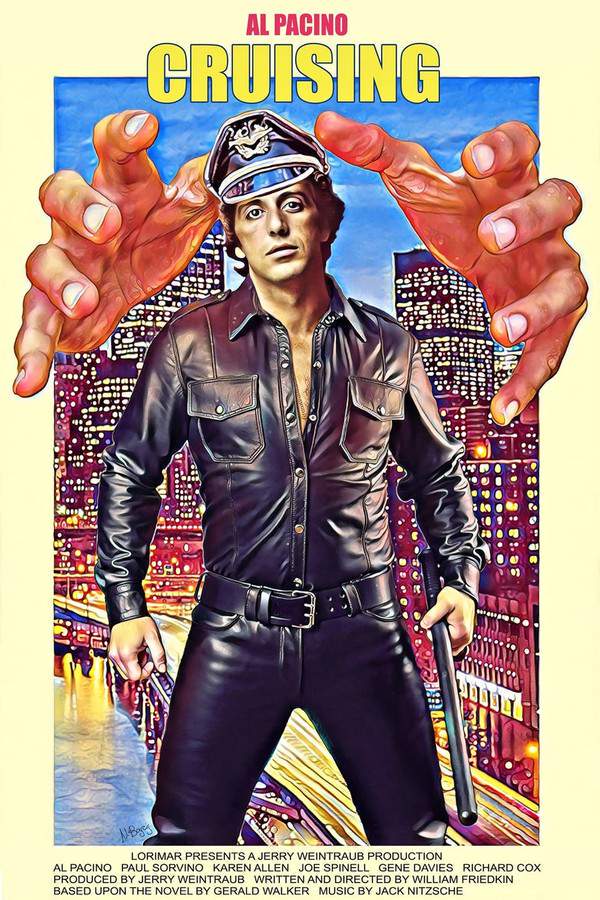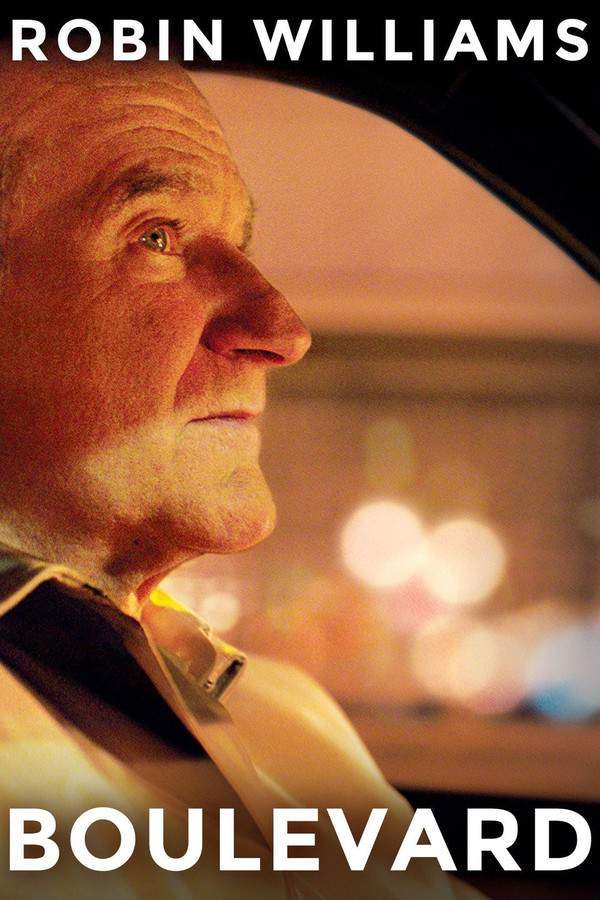
Cruising 1980
Directed by

William Friedkin
Made by

United Artists
Cruising Plot Summary
Read the complete plot summary and ending explained for Cruising (1980). From turning points to emotional moments, uncover what really happened and why it matters.
A gruesome discovery sets the tone for a chilling investigation when a severed human arm is found floating in the Hudson River. Detective Lefransky, portrayed by Randy Jurgensen of the New York Police Department, promptly commands forensic scientist Dr. Rifkin, played by Barton Heyman, to connect this dismembered limb to a torso that had been uncovered prior.
Later that evening, in a bustling gay neighborhood in Manhattan, patrolman DiSimone, portrayed by Joe Spinell, alongside his partner, Desher, engages in a disturbing encounter when they forcibly detain two transvestite prostitutes, subjecting them to sexual harassment while they are bound in their police car. Nearby, a mysterious man characterized by his sunglasses and a sinister black leather jacket steps into a gay nightclub buzzing with men dancing, loving, and indulging in public displays of sadomasochism. In an unsettling turn, a patron named Loren Lukas approaches this man, and after some interaction, they retreat to a room at the St. James Hotel. There, under the cover of a dark and unsettling atmosphere, the man ties Lukas’s hands and feet, and eerily sings, “I’m here, you’re here, we’re here,” before committing a heinous act of murder, poignantly asserting, “you made me do that.”
In the sterile environment of the forensics lab, Dr. Rifkin examines Lukas’s lifeless body and astounds Captain Edelson, played by Paul Sorvino, with grim news about the killer’s DNA redundancy—an indication of sterility due to the absence of sperm in the found ejaculate. As the investigation unfolds, they question DaVinci, a transvestite played by Gene Davis, who reveals the traumatic truth of being coerced into a sexual act by the aggressive patrolman DiSimone. Despite DaVinci’s harrowing tale, Edelson displays skepticism, fueling a tension that lingers over the inquiry.
The plot thickens as Steve Burns, enacted by the remarkable Al Pacino, a youthful and ambitious officer, enters the scene. He is ordered by Captain Edelson to go undercover, posing as a homosexual to delve deeper into the murders of Lukas and a renowned gay college professor, Paul Vincent. As he reports to Edelson’s office, he initiates the important brief about these vengeful killings, pushing himself into a covert operation that leads to unforeseen dangers.
In a deeply personal moment, Steve confesses to his girlfriend, Nancy, played by Karen Allen, that he has to undertake this potentially perilous assignment that will inevitably distance him from her, referring to it as his “deep undercover” work. During his infiltration into a polarized society, he adopts the alias “John Forbes” and mingles among the community, hitting the streets of the West Village where he befriends a neighbor, Ted Bailey, portrayed by Don Scardino. Their innocent lunch talk quickly leads into the chilling underbelly of the neighborhood’s dark happenings.
As the depths of the investigation reveal more sinister encounters, Steve witnesses the gruesome aftermath as the killer finds another victim, Eric Rossman, in a park and brutally takes his life, taunting him with songs echoing his earlier crimes. After a series of events that tug at his emotional stability while concurrently testing his dedication to the case, Steve experiences troubling dreams and a troubling disconnection from Nancy. They share moments of passion even as Steve wrestles the ghosts of his undercover life.
A tense series of criminal events follows—the fashion designer Martino Perry, who meets a gruesome fate, underlining the urgency for the police to resolve these murders before an important political event. Steve’s constant plunge into the nightlife and sordid activities leads him to discover connections between the victims and potential suspects. At the home of the killer, Stuart Richards, tensions escalate as Steve’s stakeout threatens to flicker into violence, culminating in an arrest made under the guise of deception.
With dark motivations and a descent into madness revealed, Stuart Richards’s reveal as the killer adds layers to the chilling narrative. The unsettling finale weaves Steve back into a world he sought to leave behind when he decides to return to Nancy, who unknowingly picks up his sinister artifacts associated with the killer—a twist that leaves viewers unsettlingly aware of the overlap between his life and that of the murderer.
In the tense confrontation between Steve and Richards, the door closes on a story that reflects on the complexities of identity, the brutality hidden beneath societal norms, and a haunting reminder that some masks are harder to remove than others.
Cruising Timeline
Follow the complete movie timeline of Cruising (1980) with every major event in chronological order. Great for understanding complex plots and story progression.
Discovery of the Arm
A severed human arm is discovered floating in the Hudson River, alarming investigators. Detective Lefransky from the NYPD orders Dr. Rifkin to assist in determining if this arm matches a torso found earlier, marking the beginning of a chilling investigation.
Nightclub Encounter
In a predominantly gay neighborhood, patrolmen DiSimone and Desher harass two transvestite prostitutes, exemplifying the systemic abuse in the police force. Nearby, a man in a black leather jacket enters a gay nightclub, where he soon becomes involved in a grim turn of events.
Murder of Loren Lukas
The man in sunglasses, after leaving the nightclub with patron Loren Lukas, ties him up in a hotel room and brutally stabs him while singing a haunting tune. This murder raises alarm in the already tense environment as the struggle against violence in the gay community begins.
Forensic Analysis
Dr. Rifkin conducts an autopsy on Loren Lukas's body but discovers a perplexing detail: the killer’s DNA can’t be determined due to the lack of sperm in the ejaculate. This leads to an investigation focusing on a sterile killer, narrowing down the search for suspects.
Undercover Assignment
Detective Captain Edelson briefs young officer Steve Burns about the string of murders and instructs him to go undercover. He must pose as a homosexual to investigate the killings, indicating the challenges and dangers of his upcoming mission.
Adapting to the Scene
Moving to a gay neighborhood, Steve meets his neighbor Ted, and they discuss the recent murders. As Steve starts adapting to his undercover role, he engages with the community by visiting gay bars and immersing himself in the atmosphere.
Eric Rossman's Murder
In a park, the killer lures Eric Rossman into the woods under the pretense of intimacy but ultimately stabs him to death. The chilling echo of 'You made me do that' indicates the disturbed psyche of the murderer, revealing a pattern of violence.
Tensions Rise with Nancy
Steve's undercover work strains his relationship with his girlfriend Nancy, as he confides in her about the dangers of his job. The emotional toll of living a double life begins to surface, affecting both his personal life and his mission.
Martino Perry's Death
Fashion designer Martino Perry tragically meets the killer after following him into a peep show booth. The brutal stabbing solidifies the notion that the murder spree is escalating, prompting urgency within the police department.
Searching for Leads
As the pressure mounts from the Chief of Detectives to solve the case before the upcoming Democratic National Convention, Steve asks about Skip Lee, acquiring insights into the locals and their complex relationships. This leads him deeper into the investigation.
Confronting Skip Lee
Detective Lefransky finds DaVinci, who identifies Skip Lee as a suspect. The investigation takes a turn when Steve sets a trap for Lee, leading to a tense standoff in a motel room where their interactions are secretly monitored.
Unraveling Clues
Steve discovers crucial evidence linking Stuart Richards's writings to the murder spree. This revelation highlights the psychological aspects of the killer and connects the dots leading to the suspect’s possible motives.
Final Confrontation
Steve confronts Stuart Richards in a tunnel, attempting to arrest him. The situation escalates, leading to a violent clash where Steve manages to stab Richards and take him into custody, bringing the investigation to a climax.
Arrest and Confession
After his arrest, Richards is confronted by Edelson, who offers him a deal in exchange for a confession. The investigation culminates in Richards's admission to the murders, revealing the complexities surrounding his actions and relationships.
Dark Legacy
After the conclusion of the case, while Steve prepares to return to his life, he unknowingly leaves behind reminders of his undercover work. Nancy's discovery of his belongings hints at the twisted connections of their lives and the lingering shadows of his dark experience.
Cruising Characters
Explore all characters from Cruising (1980). Get detailed profiles with their roles, arcs, and key relationships explained.
Steve Burns (Al Pacino)
Steve Burns is a young policeman who takes on a high-stakes undercover assignment to investigate a series of murders in the gay community. Throughout the film, he struggles with the emotional toll of his dual identity while forming complex relationships that blur professional boundaries. His journey reflects the challenges of grappling with societal norms and personal connections.
Detective Lefransky (Randy Jurgensen)
Detective Lefransky is a seasoned member of the New York Police Department who leads the investigation into the gruesome murders. As a cynical and pragmatic figure, he embodies the tension between duty and personal beliefs, often clashing with the community's complexities. His commitment to solving the case reveals the darker shadows of policing in sensitive areas.
Captain Edelson (Paul Sorvino)
Captain Edelson is the authoritative figure overseeing the investigation, often balancing departmental pressures with the need for justice. His character represents institutional challenges in addressing crimes against marginalized groups while grappling with his own biases. Edelson's leadership is crucial in navigating the high tension of the precinct during a volatile period.
Cruising Settings
Learn where and when Cruising (1980) takes place. Explore the film’s settings, era, and how they shape the narrative.
Time period
1980s
The film is set in the 1980s, a decade that experienced significant cultural shifts, especially regarding sexuality and the LGBTQ+ community. This period was marked by the rise of the gay rights movement and heightened societal conflicts surrounding these issues. The backdrop of the early 1980s also adds an air of tension, as it leads into the onset of the AIDS epidemic.
Location
New York City, West Village, Hudson River
The story unfolds in New York City, particularly focusing on the vibrant yet dangerous West Village, known for its rich LGBTQ+ history. The Hudson River serves as a stark backdrop, where a severed human arm is discovered, sparking the investigation. The contrasting settings of lively gay nightclubs and ominous alleys exemplify the hidden dangers within this urban landscape.
Cruising Themes
Discover the main themes in Cruising (1980). Analyze the deeper meanings, emotional layers, and social commentary behind the film.
🔍
Identity
The theme of identity plays a crucial role as the protagonist, Steve Burns, goes undercover to navigate the gay community. This exploration forces him to confront his own identity and assumptions about sexuality while putting him in morally ambiguous situations. It questions societal perceptions of masculinity and the impact of secrecy on personal relationships.
🗡️
Violence
Cruising highlights the dark underbelly of urban life, where violence lurks beneath the surface of social interaction. The brutal murders create an atmosphere of fear, particularly within marginalized communities. This theme examines the consequences of unchecked aggression and the psychological scars that violence inflicts on individuals involved.
Movies with Similar Twists and Themes
Uncover films that echo the narrative beats, emotional arcs, or dramatic twists of the one you're exploring. These recommendations are handpicked based on story depth, thematic resonance, and spoiler-worthy moments — perfect for fans who crave more of the same intrigue.
Featured on this page

What's After the Movie?
Not sure whether to stay after the credits? Find out!
Explore Our Movie Platform
New Movie Releases (2025)
Famous Movie Actors
Top Film Production Studios
Movie Plot Summaries & Endings
Major Movie Awards & Winners
Best Concert Films & Music Documentaries
© 2025 What's After the Movie. All rights reserved.










